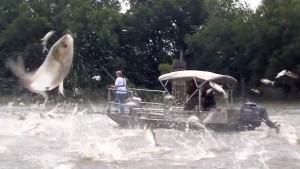“You’re taking your life in your own hands if you go waterskiing on some parts of the Illinois River,” observes aquatic invasive species expert Phil Moy of the University of Wisconsin Sea Grant. He’s talking about the Silver Asian Carp that have infiltrated much of the Mississippi River System.
The threat to life and limb comes from the carp leaping out of the water when startled by loud noise, like the roar of an engine. It’s changed life and culture in communities along the Illinois River south of Peoria. Bath, Illinois, hosts an annual Redneck Fishing Tournament where fisherman compete for the largest haul of Silver Carp either by catching them mid-air with a net or just letting them flop into the boat. The most recent competition netted nearly nine thousand of the invasive fish.
The changes in the river have been much more dramatic, and destructive, for native species. The Silver carp and the related Bighead carp are crowding out more desirable fish. “They are quite prolific and they can compete directly with other fish that eat the plant plankton or animal plankton. And animal plankton forms the first food for essentially every sport fish species,” says Moy.
That voracious appetite for plankton is the reason Asian carp were first imported to the United States. Commercial catfish farmers in the South employed them to keep their ponds clean and clear. But flooding allowed the fish entry into the Mississippi ecosystem.
 As carp populations have expanded northward, the fish have gotten closer and closer to Lake Michigan. If they become established in the Great Lakes, they have the potential to wipe out a seven billion dollar fishery. “The commercial fishery regularly refers to itself as the largest fresh water fishery in the world” says Peter Annin, author of The Great Lakes Water Wars.
As carp populations have expanded northward, the fish have gotten closer and closer to Lake Michigan. If they become established in the Great Lakes, they have the potential to wipe out a seven billion dollar fishery. “The commercial fishery regularly refers to itself as the largest fresh water fishery in the world” says Peter Annin, author of The Great Lakes Water Wars.